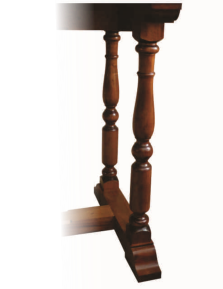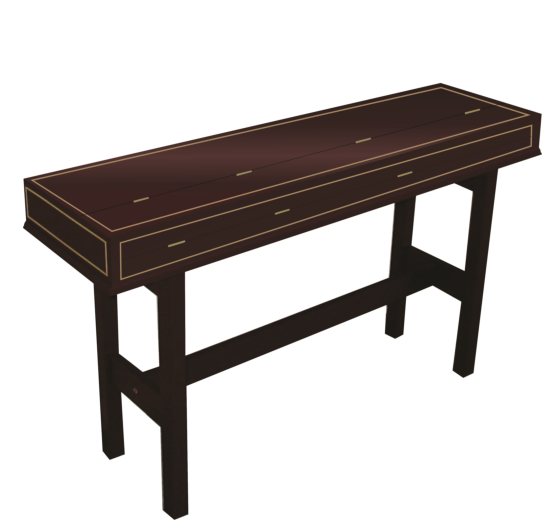
Home







The Clavichord
Christian Gottlob Hubert
After Christian Gottlob Hubert 1784, Russell Collection, Edinburgh.
From
the
eighteen
instruments
by
this
maker
that
have
survived
the
clavichord
at
Edinburgh
is
the
most
compact
in
size
being
only
1280mm
long.
Like
the
original
it
has
good
volume
and
a
responsive
action. A compact and sonorous clavichord.
Specification:
Compass:
C
–
f
‘’’.
Fretted
from
f
'-
e"'
with
all
a’s
&
d’s
free.
Overwound
strings in the bass.
Dimensions:
Approximate excluding lid & base mouldings:
Length:
1280mm, Width: 350mm, Height: 115mm.
Weight:
Approx. 35 Kg.



Clavichords
from
Spain
and
Portugal
are
quite
rare,
numbering
under
30
in
total.
This
instrument
is
one
of
three
that
are
so
similar
in
size
and
detail
it
is
thought
they
may
have
come
from
the
same
workshop.
It
is
a
fretted
clavichord
and
unlike other traditions it is the b’s and e’s that are left unfretted.
Twined strings are used in the bass.

Iberian Clavichord Anon.
After 18
th
century Anon.
c
.1750-75
©2019 Carl Rennoldson BSc.
Johan Bohak
After Johann Bohak, Vienna 1794. Royal College of Music, London. RCM 177.
Only one clavichord is known by this maker however two square pianos by him are extant.
The
instrument,
said
to
have
once
been
the
property
of
Joseph
Haydn,
is
unusual
in
that
although
having
a
full
five
octave
compass
has
an
overall
length
of
only
1458mm.
This
is
about
300mm
shorter
than
an
average
five
octave
instrument.
The
case
is
fine
but
robustly
made
and
has
the
unique
feature
of
an
original
laminated soundboard made from two thin layers of veneer.



Specification:
Compass:
FF
–
f
‘’’
unfretted.
Overwound
strings in the bass.
Dimensions:
Approximate
excluding
lid
&
base
mouldings:
Length:
1458mm,
Width:
475mm,
Depth:
165mm.
Weight:
Approx. 43Kg.
Specification:
Compass:
C – e’’’ Twined strings from C - e
b
Dimensions:
Approximate excluding lid & base mouldings
Length:
1130mm,
Width:
344mm,
Depth:
110mm







Home







The Clavichord
Christian Gottlob Hubert
After Christian Gottlob Hubert 1784, Russell Collection, Edinburgh.
From
the
eighteen
instruments
by
this
maker
that
have
survived
the
clavichord
at
Edinburgh
is
the
most
compact
in
size
being
only
1280mm
long.
Like
the
original
it
has
good
volume
and
a
responsive
action. A compact and sonorous clavichord.
Specification:
Compass:
C
–
f
‘’’.
Fretted
from
f
'-
e"'
with
all
a’s
&
d’s
free.
Overwound
strings in the bass.
Dimensions:
Approximate excluding lid & base mouldings:
Length:
1280mm, Width: 350mm, Height: 115mm.
Weight:
Approx. 35 Kg.



Clavichords
from
Spain
and
Portugal
are
quite
rare,
numbering
under
30
in
total.
This
instrument
is
one
of
three
that
are
so
similar
in
size
and
detail
it
is
thought
they
may
have
come
from
the
same
workshop.
It
is
a
fretted
clavichord
and
unlike other traditions it is the b’s and e’s that are left unfretted.
Twined strings are used in the bass.

Iberian Clavichord Anon.
After 18
th
century Anon.
c
.1750-75
©2019 Carl Rennoldson BSc.
Johan Bohak
After Johann Bohak, Vienna 1794. Royal College of Music, London. RCM 177.
Only one clavichord is known by this maker however two square pianos by him are extant.
The
instrument,
said
to
have
once
been
the
property
of
Joseph
Haydn,
is
unusual
in
that
although
having
a
full
five
octave
compass
has
an
overall
length
of
only
1458mm.
This
is
about
300mm
shorter
than
an
average
five
octave
instrument.
The
case
is
fine
but
robustly
made
and
has
the
unique
feature
of
an
original
laminated soundboard made from two thin layers of veneer.



Specification:
Compass:
FF
–
f
‘’’
unfretted.
Overwound
strings in the bass.
Dimensions:
Approximate
excluding
lid
&
base
mouldings:
Length:
1458mm,
Width:
475mm,
Depth:
165mm.
Weight:
Approx. 43Kg.
Specification:
Compass:
C – e’’’ Twined strings from C - e
b
Dimensions:
Approximate excluding lid & base mouldings
Length:
1130mm,
Width:
344mm,
Depth:
110mm






